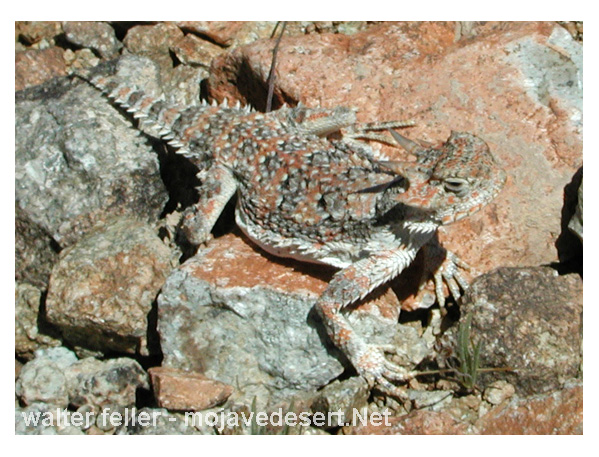Desert Horned Lizard

Desert Horned Lizard (Phrynosoma platyrhinos)
Family: Phrynosomatidae | Order: Squamata | Class: Reptilia
Distribution and Habitat
The desert horned lizard is a common year-round resident of the Mojave, Sonoran, and Colorado deserts, with an isolated population in the San Jacinto River Wash, Riverside County. It inhabits desert shrublands, sandy washes, and grass/forb stages of pine-juniper woodlands, preferring open, sparsely vegetated areas. This species occurs from below sea level up to approximately 2,130 meters (7,000 feet) in elevation. Activity varies by elevation, with peak movement from April to July at lower elevations and May to September at higher elevations.Diet and Foraging Behavior
The desert horned lizard primarily feeds on ants but also consumes beetles, larvae, and some plant material. It uses a sit-and-wait hunting strategy, remaining motionless until prey comes within reach. Foraging typically occurs in sandy or rocky areas where insect activity is high.Shelter and Reproduction
This species favors loose, sandy soils for burrowing but is also found in gravelly desert washes. Eggs are laid in well-drained, sandy soil, with the breeding season occurring from May to June. Most eggs are deposited in June and early July, with clutch sizes ranging from 7 to 13 eggs.Activity Patterns and Behavior
The desert horned lizard is diurnal, becoming active as temperatures rise in spring and hibernating during cooler months. It does not migrate but maintains a small home range, typically between 18 to 22.5 meters (59 to 74 feet) in diameter. While territorial behavior is not well-developed, individuals use visual displays to assert dominance when needed.Predation and Defense Mechanisms
This species shares its range with the flat-tailed horned lizard and is preyed upon by birds of prey, roadrunners, and some snakes. Leopard lizards may also pose a threat. To deter predators, the desert horned lizard relies on its cryptic coloration, remaining motionless to blend into its surroundings. When threatened, it can flatten its body, inflate slightly, or use sudden movements to startle predators. Some horned lizard species have the ability to squirt blood from their eyes as a defense mechanism, but this behavior is not commonly observed in the desert horned lizard.Ecological Role
As an insectivore, the desert horned lizard plays an important role in controlling ant and beetle populations within its desert ecosystem. It is an integral part of the arid food web, both as a predator and a prey species.Phrynosoma platyrhinos
Family: Phrynosomatidae Order: Squamata Class: Reptilia hawks.
Leopard lizards and snakes
The desert horned lizard (Phrynosoma platyrhinos) is a year-round resident of the Mojave, Sonoran, and Colorado deserts, favoring open, sandy habitats. It primarily feeds on ants using a sit-and-wait hunting strategy. Active from spring to summer, it hibernates in cooler months. Breeding occurs from May to June, with clutches of 7 to 13 eggs laid in sandy soil. Predators include birds, snakes, and lizards, but its camouflage and defensive behaviors provide protection. As an insectivore, it plays a key role in desert ecosystems.
|
The Desert Food Chain * Everything has its niche. Who eats what, and what eats who in the desert? Click here to find out what more. |